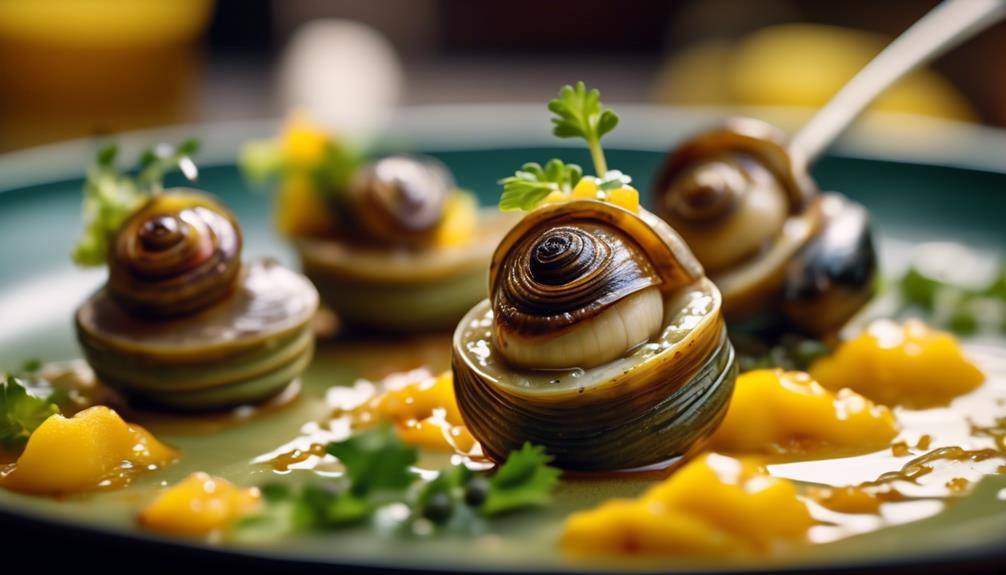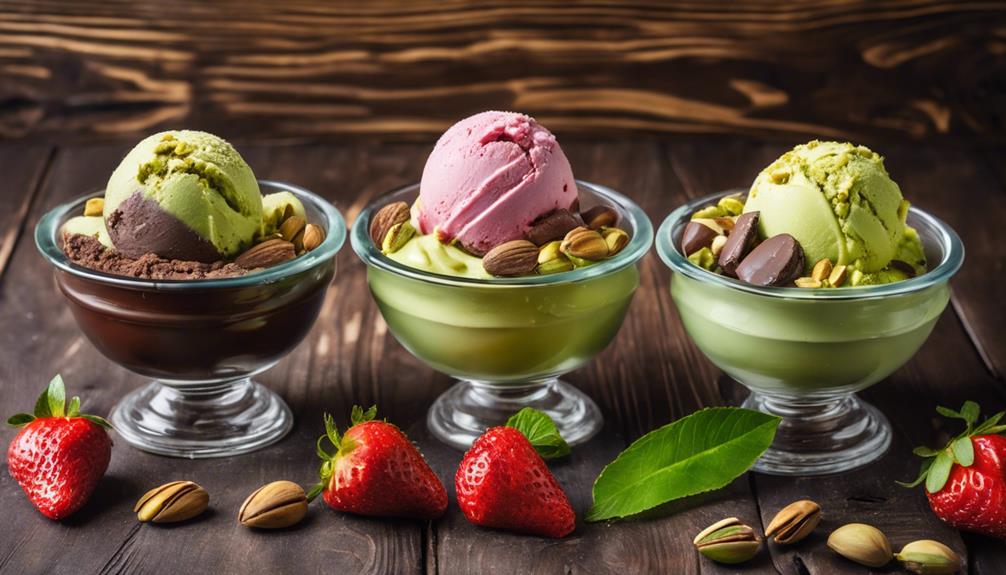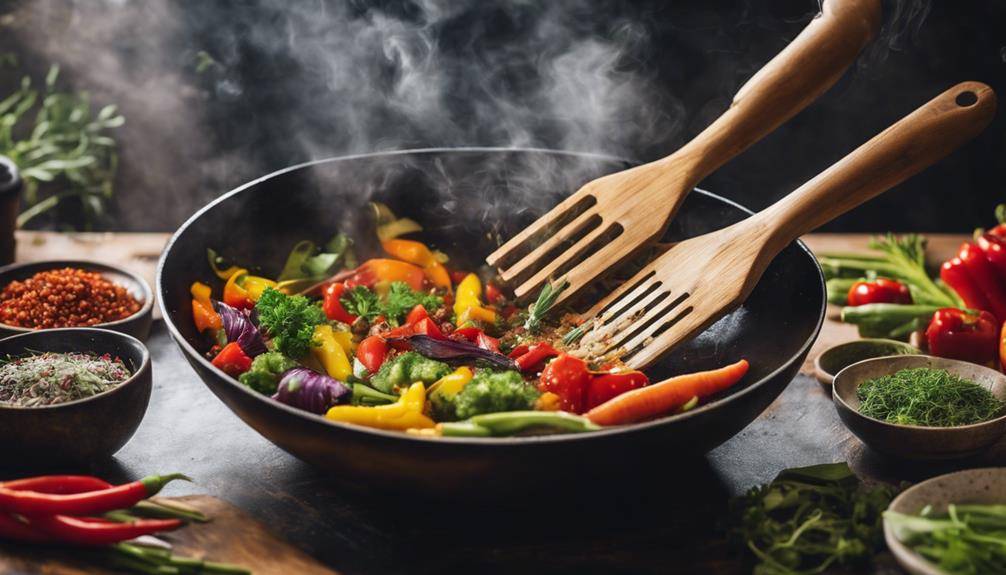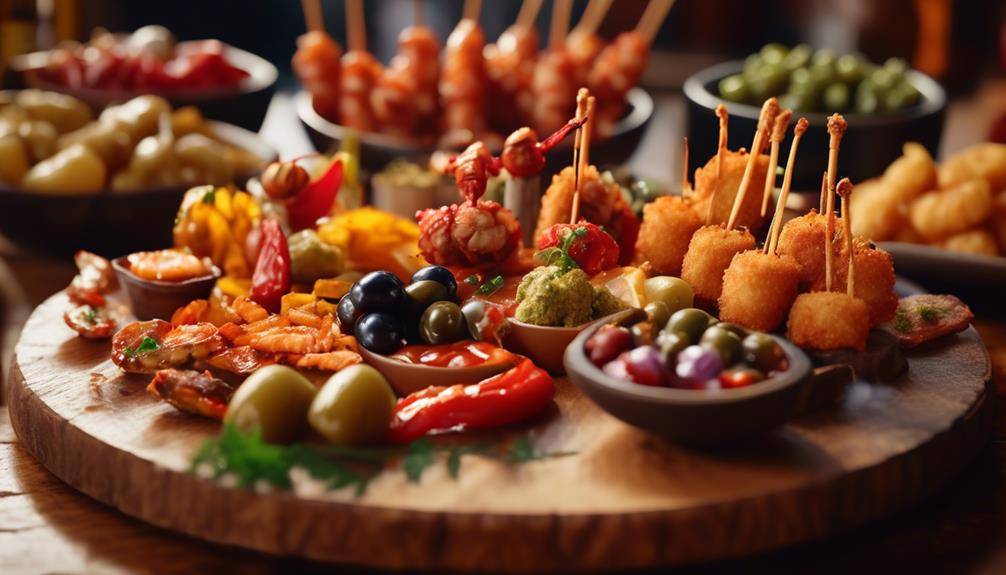10 Amazing Peruvian Food Customs And Traditions
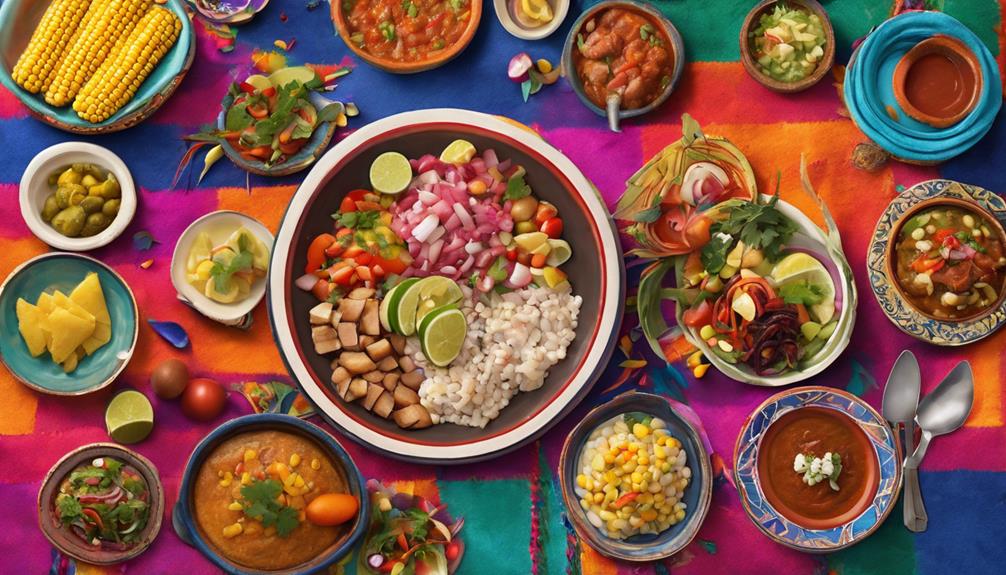
To truly appreciate Peruvian Food Customs And Traditions, you’ve got to understand the communal spirit that permeates meals. Family gatherings often feature potlucks, where everyone contributes a dish, blending flavors and stories. You’ll find rich heritage in ingredients like quinoa and over 4,000 types of potatoes. Celebratory dishes like pachamanca connect you to the land, while street food culture offers a vibrant taste of urban life. Rituals surrounding food also honor the spiritual significance in many traditions. By embracing these practices, you connect with Peru’s culinary heart and the stories behind each dish. Keep exploring to uncover even more delicious customs!
Community Gatherings
In Peru, countless community gatherings revolve around food, showcasing the country’s rich culinary heritage. Whether it’s festive potlucks or neighborhood cookouts, these events bring people together to celebrate and share their culinary traditions. You’ll find that potluck gatherings are especially popular, where each guest contributes a dish, allowing everyone to experience a diverse array of flavors and recipes.
As you join these communal feasts, you’ll witness vibrant cultural exchanges. People from different backgrounds come together, swapping stories and recipes that have been passed down through generations. Each dish carries its own story, and food storytelling plays a crucial role in these gatherings. It’s not just about the meal; it’s about sharing the love and history behind it.
During these events, you might discover new favorites or learn how to prepare a dish that’s been cherished in someone’s family for years. The act of sharing recipes fosters a sense of connection and belonging, enriching your understanding of Peruvian culture.
From the aroma of grilled meats to the colorful spread of salads and desserts, every gathering becomes a celebration of community and tradition. So, whether you’re cooking up a classic dish or trying something new, remember that these communal feasts are more than just meals. They’re opportunities to connect, learn, and continue the culinary traditions that define Peru. Get ready to savor the flavors and stories that make each gathering unique!
Traditional Ingredients
When you explore Peruvian cuisine, you’ll discover a rich array of traditional ingredients that reflect the region’s diverse landscapes. Native Andean staples like quinoa and potatoes play an essential role, while regional flavor variations bring unique twists to familiar dishes. Understanding these key ingredients helps you appreciate the depth of Peru’s culinary heritage.
Native Andean Staples
The heart of Peruvian cuisine beats with native Andean staples that have nourished generations. You’ll discover that quinoa cultivation, one of the ancient grains revered for its nutritional benefits, plays a pivotal role in Andean cuisine. This versatile grain isn’t just a food source; it’s a symbol of culinary heritage, deeply rooted in local farming traditions.
Potato varieties are another cornerstone of this rich culinary landscape. With over 4,000 types grown in the Andes, each offers unique flavors and textures that enhance traditional cooking. These indigenous flavors, celebrated in countless dishes, reflect the region’s crop diversity and the creativity of its people.
As you explore Peruvian food, you’ll appreciate how these native ingredients come together to form a vibrant tapestry of tastes. From hearty stews to light salads, the use of quinoa and potatoes showcases a commitment to preserving Andean traditions while promoting sustainable local farming practices. The nutritional benefits of these staples not only feed the body but also connect you to the culture and history of the Andes. Embrace the richness of these native staples, and savor the essence of Peru’s culinary identity.
Regional Flavor Variations
Peruvian cuisine bursts with regional flavor variations that showcase the country’s diverse geography and cultures. You’ll find coastal cuisine rich in seafood, with ceviche being a standout, highlighting fresh fish marinated in zesty lime and spices. In the jungle, specialties like juanes—a rice and meat dish wrapped in banana leaves—reflect indigenous ingredients that create unique flavors.
Highland flavors take center stage with hearty dishes like pachamanca, where meats and vegetables are cooked underground with hot stones, bringing out festive flavors. Urban influences make their way into fusion dishes, blending traditional recipes with global cuisines, showcasing Peru’s culinary creativity.
Spice variations are also significant; you might notice aji peppers in sauces or as a garnish, adding heat and depth to many meals. Don’t forget to indulge in traditional beverages like chicha morada, a sweet corn drink, which pairs perfectly with regional dishes.
Seasonal ingredients play a critical role too, ensuring that every dish honors the harvest. So, whether you savor a coastal delicacy or a highland feast, each bite is a reflection of Peru’s vibrant culinary tapestry.
Rituals of Preparation
Although many cultures have their own cooking traditions, the rituals of preparation in Peru stand out for their deep connection to the land and community. When you step into a Peruvian kitchen, you’ll likely witness ceremonial cooking that goes beyond just making a meal; it’s a way of honoring the ingredients and the people involved. You’ll find that many families use ancestral techniques passed down through generations, ensuring that these traditions remain alive.
As you prepare a dish, you might begin by selecting fresh produce from local markets, where vibrant colors and aromas awaken your senses. Each ingredient isn’t just a component but a symbol of the region’s rich agricultural heritage. You’ll be encouraged to acknowledge the land and the farmers who grew the food, fostering a sense of gratitude.
Incorporating these ancestral techniques, you may employ methods like using traditional clay pots or stone grinding tools, allowing the flavors to develop in a way that modern appliances can’t replicate. The act of cooking becomes a shared experience, often involving family members who gather around, sharing stories and laughter as they chop, mix, and taste.
Ultimately, these rituals of preparation create a deep sense of community and belonging. You’ll discover that every meal is a celebration of Peru’s history, culture, and the bonds that tie people together, making the act of cooking something truly special.
Celebratory Dishes
Cooking rituals naturally lead to the creation of celebratory dishes that showcase Peru’s vibrant culinary heritage. During holiday feasts, you’ll find an array of colorful dishes that not only tantalize the taste buds but also tell stories of tradition and community. At festive gatherings, families come together to prepare these meals, engaging in communal cooking that strengthens bonds and preserves ancestral recipes.
Traditional celebrations, like Inti Raymi or Christmas, feature heritage foods that embody food symbolism. For instance, you might enjoy a hearty plate of pachamanca, which involves cooking marinated meats and vegetables underground. This dish represents the connection between the earth and the people, celebrating abundance and gratitude. You’ll notice that the flavors of each dish are deeply rooted in Peru’s diverse cultural heritage, reflecting the influences of Indigenous, Spanish, and Asian cuisines.
As you savor these dishes, you experience more than just a meal; you partake in the essence of Peruvian identity. Each bite can evoke memories of past gatherings and the stories that have been passed down through generations. Whether it’s the sweet aroma of panetón during the holidays or the rich taste of ceviche shared among friends, these celebratory dishes create a tapestry of flavors that enrich your understanding of Peru’s culinary landscape. So next time you’re at a festive gathering, embrace the opportunity to indulge in these dishes and connect with the heart of Peruvian culture.
Food and Religion
Food often serves as a powerful medium for spiritual expression and community bonding in various cultures, and Peru is no exception. In the Andean traditions, sacred meals play an essential role, often prepared during religious feasts to honor deities and ancestors. These meals aren’t just about nourishment; they embody culinary symbolism that reflects the culture’s values and beliefs.
Fasting traditions are also significant in many Peruvian religious practices. During specific periods, you might find communities engaging in fasting, which deepens their spiritual connection and appreciation for food. When the fast concludes, celebratory dishes made from divine recipes are shared, reinforcing communal ties.
Food offerings are common during rituals, where sacred herbs like muña and coca are used to invoke blessings and express gratitude. These offerings are not merely symbolic; they serve as a way to connect with the divine and seek harvest blessings for the community. You’ll often see festive banquets filled with traditional dishes, where communal prayers are recited, creating an atmosphere of unity and reverence.
As you explore Peru’s food customs, you’ll discover how deeply intertwined food and religion are in everyday life. From the preparation of sacred meals to the sharing of food during ceremonies, each bite carries a piece of history and spirituality, inviting you to participate in this rich cultural tapestry. Through these shared experiences, you’ll find a profound connection to the people and their beliefs.
Seasonal Festivals
In Peru, the vibrant tapestry of seasonal festivals reflects the deep-rooted connection between food, culture, and community. These festivals, often tied to agricultural cycles, celebrate the harvest and the bounty of the land. You’ll find that every region has its own unique customs, but they all share a common thread: a love for food and togetherness.
During harvest celebrations, communities gather to honor the fruits of their labor. You might witness colorful parades filled with dancers in traditional attire, showcasing local folklore. As the sun sets, the air fills with the sounds of traditional music, drawing people in to dance and revel in the joy of the season. The rhythm of the drums and the melodies of flutes create an atmosphere that’s both festive and inviting.
Food plays a central role in these festivals. You’ll savor dishes made from freshly harvested ingredients, often prepared in communal kitchens. Locals share their favorite recipes, showcasing the diversity of Peruvian cuisine. From hearty stews to sweet treats, each dish tells a story that connects you to the land and the people.
Attending a seasonal festival in Peru isn’t just about the food; it’s an opportunity to immerse yourself in the culture and traditions that bind communities together. You’ll leave with more than just a full stomach; you’ll carry with you the warmth of shared experiences and the rhythms of traditional music that echo in your heart long after the celebrations have ended.
Family Recipes
Peruvian family recipes hand down cherished traditions that connect generations, bringing loved ones together around the table. These heirloom recipes are often passed down from grandparents to parents, and eventually to you, preserving the rich flavors and stories of your family’s history. Each dish carries the weight of memories, celebrating milestones and everyday moments alike.
When you gather around the dinner table, you’re not just sharing a meal; you’re engaging in culinary storytelling. Each bite of your grandmother’s adobo or your mother’s causa reflects the love and care that went into preparing it. These recipes often include local ingredients, showcasing the vibrant diversity of Peru’s landscape—from coastal fish to Andean potatoes.
As you cook these dishes, you might find yourself recalling the stories behind them: how your family adapted them through the years or the laughter that filled the kitchen during their preparation. You’re not just following a recipe; you’re honoring your heritage and keeping the spirit of your ancestors alive.
Incorporating these heirloom recipes into your own life helps to guarantee that the flavors and traditions of Peru continue to thrive. You can even add your own twist, making these recipes uniquely yours while still respecting the original. By sharing these meals with friends and family, you’re fostering connection and creating new memories that will, in turn, become part of your own culinary storytelling for future generations.
Street Food Culture
When you stroll through the bustling streets of Peru, you’re bound to encounter a vibrant street food scene. From savory anticuchos to sweet picarones, local vendors offer a taste of the country’s rich culinary heritage. This street food culture not only satisfies your cravings but also reflects the community’s traditions and shared experiences.
Popular Street Food Choices
Street vendors fill the bustling streets of Lima, offering a vibrant array of delicious options that showcase Peru’s rich culinary heritage. You can’t miss the numerous ceviche variations, each stall boasting its unique twist on this iconic dish, featuring fresh fish marinated in tangy lime juice. Anticuchos have gained immense popularity, with skewered beef heart grilled to perfection, making it a must-try for street food enthusiasts.
As you explore, you’ll encounter various empanada styles, from savory beef to sweet dessert versions, each bite bursting with flavor. Don’t forget to sip on chicha, a traditional beverage with deep roots in Peruvian culture, often made from fermented corn.
Tamale traditions bring another layer to the street food scene, with vendors serving up these hearty parcels filled with meats, cheeses, or vegetables, wrapped in corn husks. With the rise of street food innovations and food truck trends, Lima’s urban food culture continues to evolve, offering new takes on classic favorites. Embrace the adventure and indulge in the diverse offerings that make Peru’s street food scene so enchanting!
Local Vendors and Markets
Lima’s vibrant street food scene thrives thanks to its local vendors and bustling markets, where culinary traditions come alive. When you stroll through these lively spaces, you can’t help but be captivated by the aromas and colors surrounding you. Engage in market interactions with vendors who are enthusiastic to share their culinary expertise and stories behind their dishes.
You’ll find that these vendors often form close relationships with their regular customers. They know your preferences and might even suggest new items you haven’t tried yet, creating a sense of community that enhances your experience. From the sizzling anticuchos to the invigorating ceviche, each dish comes with a personal touch that reflects the vendor’s passion for their craft.
Markets like Mercado de Surquillo or Mercado Central offer a treasure trove of flavors waiting to be discovered. As you savor the street food, you’re not just enjoying a meal – you’re participating in a tradition that connects you to the heart of Peruvian culture. So, don’t hesitate to plunge into these local experiences; they’re the essence of Lima’s street food culture and the soul of its culinary heritage.
Cultural Significance of Street Food
Amidst the lively atmosphere of Peru, street food represents more than just a quick bite; it embodies a rich tapestry of culture and tradition. You’ll find that these culinary delights are integral to Peru’s culinary identity, showcasing local ingredients that reflect the country’s diverse ecosystems. As you navigate bustling streets, you’ll experience urban culture in its most vibrant form, where food accessibility is paramount.
Street food not only satisfies hunger but also fosters social bonding. Vendors often become familiar faces, creating a sense of community as locals gather to enjoy flavors of tradition together. You might witness street artistry at work, where skilled cooks showcase their craft, transforming simple ingredients into mouthwatering dishes.
Moreover, street food serves as a medium for cultural exchange, allowing you to sample influences from various regions. Each bite tells a story, connecting you to the history and heritage of the Peruvian people. As you indulge in these delicious offerings, you’ll truly appreciate how street food encapsulates the heart and soul of Peru, inviting you to savor every moment and flavor along the way.
Culinary Fusion
Peruvian cuisine often embraces culinary fusion, blending traditional ingredients and techniques with influences from various cultures. This unique approach enriches Andean cuisine, allowing you to experience a diverse range of flavors and textures. By integrating fusion techniques, chefs create dishes that reflect both the historical significance of Peru’s culinary heritage and modern interpretations that resonate with today’s diners.
As you explore the gastronomic traditions of Peru, you’ll notice how ingredient sourcing plays an important role in this fusion. Locally sourced products, such as native potatoes and fresh seafood, harmonize with spices and cooking methods introduced by immigrants from Asia, Europe, and Africa. These cultural influences contribute to the vibrant flavor profiles that make Peruvian dishes so appealing.
Culinary storytelling is essential in this fusion landscape. Each dish tells a story, weaving together the past and present through flavors that evoke memories of traditional meals while inviting new experiences. For example, a classic ceviche might incorporate Asian-inspired ponzu sauce, showcasing how culinary boundaries can blur in delightful ways.
You’ll find that chefs in Peru often experiment with these elements, crafting unique dishes that pay homage to their roots while breaking new ground. This ongoing evolution keeps the culinary scene dynamic, ensuring that every meal is not just food but a celebration of Peru’s rich and diverse heritage. By embracing culinary fusion, you’re not just tasting food; you’re engaging with a culture that thrives on innovation and tradition.
Sharing and Generosity
In Peru, sharing meals is a fundamental part of the culture that fosters community and connection. When you sit down for a meal, you’re likely to experience the warmth of generosity as dishes are passed around and everyone contributes. The act of gifting food not only nourishes the body but also strengthens relationships and creates lasting bonds.
Community Meal Practices
Gathering around a table is more than just a meal; it’s a celebration of community and generosity in Peru. You’ll find that the spirit of togetherness thrives through potluck traditions, where everyone contributes a dish, creating a vibrant feast. This practice fosters a sense of belonging, as each person shares a piece of their culinary heritage, encouraging conversation and connection.
In many neighborhoods, communal kitchens play a pivotal role in these meal practices. These kitchens serve as gathering spots where families come together to cook and share meals, often pooling resources to guarantee no one goes hungry. You’ll notice that these spaces are filled with laughter and the aroma of traditional dishes, reflecting the warmth of the community.
When you participate in these gatherings, you’re not just enjoying food; you’re engaging in a ritual that reinforces bonds among friends and family. The act of sharing meals in Peru transcends mere sustenance, emphasizing the importance of generosity and support within the community. So, whether it’s at a potluck or in a communal kitchen, you’re part of a rich tapestry of shared experiences that define Peruvian culture.
Gift of Food
Food holds a special place in the hearts of Peruvians, often seen as a gift that symbolizes sharing and generosity. When you offer food to someone, you’re not just sharing a meal; you’re extending a piece of your culinary heritage and culture. This act embodies deep food symbolism, reflecting respect, friendship, and community bonds.
In Peru, it’s common for families to prepare extra portions during gatherings, ensuring that everyone leaves satisfied. You’ll find that sharing a dish is a way to foster connections, whether it’s with neighbors or friends. This tradition underscores the value Peruvians place on hospitality and inclusiveness.
During special occasions, like birthdays or festivals, you might notice that food plays a central role in celebrations. People exchange traditional dishes, reinforcing the idea that food is a universal language of love and generosity. If you’re invited to a Peruvian home, expect to be welcomed with a plateful of delicious offerings, symbolizing not just nourishment but also a heartfelt connection. Embracing this aspect of Peruvian culture will deepen your understanding of their customs and the importance of sharing food in fostering community ties.
Frequently Asked Questions: Peruvian Food Customs And Traditions
What Are Common Dining Etiquette Practices in Peru?
When dining in Peru, you’ll notice meal sharing is common. Always wait for the host to start eating, and it’s polite to say “buen provecho” to others. Respecting these dining customs enhances your experience.
How Do Peruvians Typically Show Appreciation for a Meal?
When you enjoy a meal, you’ll notice Peruvians often express culinary gratitude through meal blessings. They might say a few kind words, showing appreciation for the food and the effort that went into preparing it.
Are There Specific Food-Related Superstitions in Peruvian Culture?
In Peruvian culture, you’ll find food omens often linked to meal rituals. For instance, spilling salt might mean upcoming arguments, while sharing food can symbolize unity and good fortune. These beliefs shape how meals are experienced.
What Role Does Gender Play in Peruvian Cooking Traditions?
In Peruvian cooking, you’ll notice gender roles shape culinary heritage notably. Women often manage daily meals, while men might handle festive dishes. This dynamic reflects both traditional family structures and evolving contemporary culinary practices in Peru.
How Do Urban and Rural Food Customs Differ in Peru?
You’ll find urban agriculture focuses on modern techniques and convenience, while rural markets emphasize traditional practices and local ingredients. Each setting reflects distinct cultural influences, shaping the diverse culinary landscape across Peru.
Conclusion
In exploring these ten essential Peruvian food customs and traditions, you’ve discovered how deeply intertwined food is with culture and community. Each dish tells a story, reflecting the rich history and diverse influences of Peru. Whether you’re gathering with family, enjoying street food, or celebrating a special occasion, remember that sharing a meal goes beyond nourishment; it’s about connection. Embrace these traditions and let them inspire your own culinary adventures, celebrating the vibrant flavors that make Peruvian cuisine so unique.



